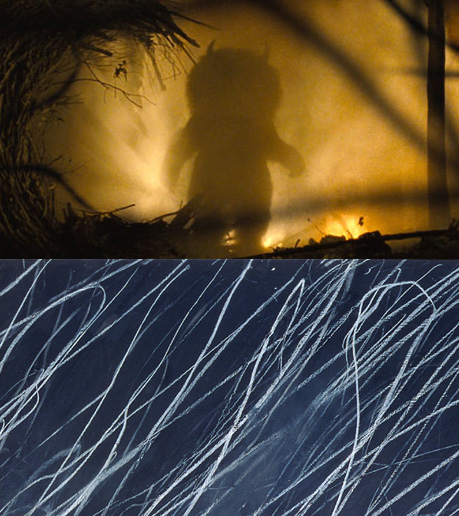Time is made to be wasted

I’ve been listening my entire adult life to parents talk about the wonders of having children and how I couldn’t possibly understand until I procreate myself. This is good-hearted and well-meaning advice intended to reinforce the age old idea that as a species we are meant to make more of our own in order to survive. These parents look at me with glazed, sleep-deprived eyes and with sadness that I am missing something meaningful and that somehow my life will never be complete because of it. Watching Where the Wild Things Are yesterday articlulated the reason that is not true for me. I don’t need to live vicariously through another’s childhood because I am always trying to persist my own. Picasso said it best; “Every child is an artist. The problem is how to remain an artist once we grow up.”
Spike Jonze is on my short list (and it’s a very short list) of people of recognition, fame or celebrity that I would like to meet someday. I’m far from a star-fucker but Jonze is a genius of the rare kind and I’m certain spending a day with him would be extraordinary. His latest film based on Maurice Sendak’s book Where the Wild Things Are is an extraordinary work of art. The word genius is thrown around with absurdity in our society today, but Jonze actually earns the title. His rare ability to channel raw emotional content as absurdist theater mimics the dynamics present in abstract expressionism or modern dance. It is an intellectual landscape that is simple but difficult and requires the viewer to step so close to the edge of psychological decompensation that many will run in terror in the other direction. Jonze understands that children live on that edge emotionally every day as they deconstruct the complexities, hypocrisy and confusion of the adult world in order to build an identity that is uniquely their own. As we grow older most people learn to accept the rules and constructs of being an adult and exchange those for the freedom and emotional liberation that comes with childhood. Those who reject them turn to art.
Adults who choose to have children are re-engaging in a dialogue with their own childhood experiences. The unbridled energy and raw emotion of childhood is thrust back into their lives but from an external perspective. They have engaged in battle, the very same battle they engaged their parents in. It’s a fight between the social constructs and rules that human beings create as adults to form civilizations and the unrestrained content of childhood. We all live in the world between the extremes of love and hate, the outer edges of fear. As adults we bind this with what we call politics, the elaborate network we use to negotiate. Children have no such network and confront emotions in a vacuum. They look to us for guidance, reassurance and love and in addition we teach them the rules we have created to contain our raw emotions; our politics. In Sendak’s book and Jonze’s movie, (Sendak consulted on the film and hand-picked Jonze to make the movie) the monsters are both stand-ins for this childhood emotion as well as representative of the politics of adulthood. The monsters can be jealous, angry, resentful, loving, caring and compassionate and all within a few moments. They seek answers to the simplest of things like negotiating each other’s personalities while persistently desiring happiness. We suppress the monsters of emotion within us everyday through our social rules and our intellectual constructs. It’s a dance with ourselves and a dance with those we interact with. Very young children lack the social dialogue (or physical ability to form words yet) to engage in this dance so they cry or scream. Less evolved adults go to war.
Where the Wild Things Are requires us, if we are to get the most from it, to live vicariously through Max’s experience and remember what it was like to be a child again. Spike Jonze could have taken the easy road on this movie and created a film that provides adults and children with a safe, fluffy kid’s film of the current paternalistic and condescending ilk that dominates children’s films today. This adult patois, a milk-toast pabulum designed to press all the right buttons in both adults and children is a superficial rendition outside of art. True art isn’t afraid to dig at our emotions and uncover the rocks conceiling our fears. Where the Wild Things Are will be powerful for children but reinforcing. Its journey shares the anxiety and uncertainty of being a child while reinforcing the security of love. It will permission children to face their fears and be bold in their emotional adventures while reinforcing that choices come with consequences. For adults, Where the Wild Things Are will open up gateways to our often sheltered cores. It will appear disorienting, confusing, and even upsetting at times. It will also provide an imaginative landscape of wonder, joy and beauty seldom experienced on screen. Let yourself go when you watch this film and it will be a cathartic and powerful experience you will not soon forget. Hopefully you’ll be reminded to find a little more fun and adventure in your life.
Top: Film still from the movie Where the Wild Things Are, 2009. Directed by Spike Jonze.
Bottom: Close-up view, Cy Twombly, Untitled, 1970. House paint and crayon on paper, 27 3/4 x 39 3/8 in. (70.5 x 100 cm).
